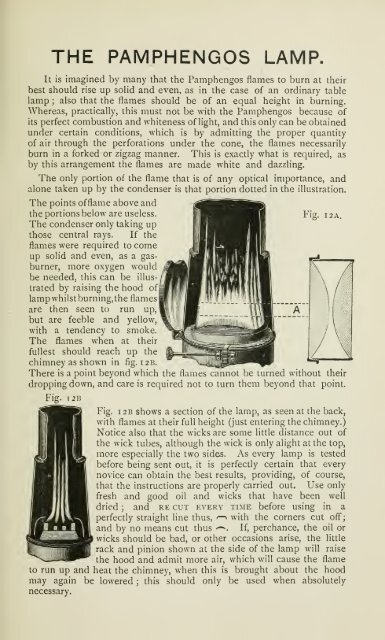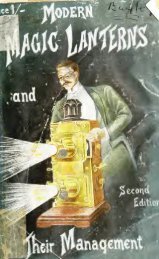perfection, combustion, <strong>and</strong> purity, to obtain which, the air supply islimited to that drawn through the perforations. <strong>The</strong>refore at some timeor other an occasion may happen, where a difificulty may arise, in gettingthe flames up to their proper st<strong>and</strong>ard, if the flames do not rise, so thatthe points <strong>of</strong> light are seen flickering up the chimney (in ten minutesfrom the time <strong>of</strong> lighting), it is very certain, that something is at fault,the cause <strong>of</strong> failure can always be attributed to the following, viz. :—Badoil, imperfect trimming <strong>of</strong> the wicks, wicks left st<strong>and</strong>ing in the oil, orwicks that have grown hard with constant use, cottons woven too tight, it<strong>of</strong>ten happens that they have become damp. In fact, the wicks are avery important item, <strong>and</strong> play a prominent part in all oil lights <strong>and</strong>deserve special attention, if woven too tight, the oil cannot make its wayfreely up the meshes, in other words, the proper capillary attraction isabsent. It is always best to obtain fresh wicks from the maker <strong>of</strong> thelamp, not looking at it from a commercial point <strong>of</strong> view, but because itis an essential item to have the proper woven cotton. That usually soldat oil stores, is far too hard, <strong>and</strong> <strong>of</strong>ten too common for this purpose.Before inserting fresh wicks, be sure they are well dried, evaporatingevery particle <strong>of</strong> moisture, by drying in front <strong>of</strong> a fire, or in the oven foran hour or so,taking care not to scorch them, spare wick which has beencarried about in the <strong>lantern</strong> case, must not be used, until it has beendried, in the above manner. In changing the old wicks turn themup, <strong>and</strong> pull out with the fingers, introducing fresh wicks from the top<strong>of</strong> the tubes <strong>and</strong> notice that they occupy the entire space <strong>of</strong> the tube, ifnot <strong>of</strong> the proper width the oil accumulates at the corners, causing aflickering <strong>and</strong> an uneven flame. Do not attempt to light them untilthey have become saturated with the oil for at least ten minutes, if thisis attempted they will Ijecome charred, when once charred no coaxingwhatever will induce the flames to rise ;the combustion line also produces charring.turning the wick too high aboveTo prevent clogging or stickingit is advisable not to have the wick longer than six inches, nor to keepthe cogs <strong>of</strong> the spindles working on one part <strong>of</strong> the wick for any length<strong>of</strong> time.After three or four exhibitions, turn the wick up <strong>and</strong> cut <strong>of</strong>f atleast half an inch, so that the cogs may work in a fresh place, this ismentioned because lamps have been sent to the maker to be put in order,because the pinions have been said to catch, or have been bent throughstraining. <strong>The</strong> real cause <strong>of</strong> this is, that the cogs continually working inone place, have worn the wick away, drawing little str<strong>and</strong>s <strong>of</strong> cotton out,which have become entangled <strong>and</strong> wound around the spindles.If instead<strong>of</strong> forcing the spindles <strong>and</strong> so bending them, about an inch <strong>of</strong> the cottonhad been cut <strong>of</strong>f the top, the evil would have at once been remedied.
THE PAMPHENGOS LAMP.It is imagined by many that the Pamphengos flames to burn at theirbest should rise up solid <strong>and</strong> even, as in the case <strong>of</strong> an ordinary tablelamp ; also that the flames should be <strong>of</strong> an equal height in burning.Whereas, practically, this must not be with the Pamphengos because <strong>of</strong>its perfect combustion <strong>and</strong> whiteness <strong>of</strong> light, <strong>and</strong> this only can be obtainedunder certain conditions, which is by admitting the proper quantity<strong>of</strong> air through the perforations under the cone, the flames necessarilyburn in a forked or zigzag manner. This is exactly what is required, asby this arrangement the flames are made white <strong>and</strong> dazzling.<strong>The</strong> only portion <strong>of</strong> the flame that is <strong>of</strong> any optical importance, <strong>and</strong>alone taken up by the condenser is that portion dotted in the illustration.<strong>The</strong> points <strong>of</strong>flame above <strong>and</strong>the portions below are useless.lll^^^^^^HI -^'S- ^'^^^<strong>The</strong> condenser only taking upthose central rays. If theflames were required to comeup solid <strong>and</strong> even, as a gasburner,more oxygen wouldbe needed, this can be illustratedby raising the hood <strong>of</strong>lamp whilst burning,the flamesare then seen to run up,but are feeble <strong>and</strong> yellow,with a tendency to smoke.<strong>The</strong> flames when at theirfullest should reach up thechimney as shown in fig. 12B.<strong>The</strong>re is a point beyond which the flames cannot be turned without theirdropping down, <strong>and</strong> care is required not to turn them beyond that point.Fig.12BFig. I2B shows a section <strong>of</strong> the lamp, as seen at the back,with flames at their full height (just entering the chimney.)Notice also that the wicks are some little distance out <strong>of</strong>the wick tubes, although the wick is only alight at the top,more especially the two sides. As every lamp is testedbefore being sent out, it is perfectly certain that everynovice can obtain the best results, providing, <strong>of</strong> course,that the instructions are properly carried out. Use onlyfresh <strong>and</strong> good oil <strong>and</strong> wicks that have been welldried ; <strong>and</strong> RE cut every time before using in aperfectly straight line thus, '— » with the corners cut <strong>of</strong>f;<strong>and</strong> by no means cut thus ^^. If, perchance, the oil orwicks should be bad, or other occasions arise, the littlerack <strong>and</strong> pinion shown at the side <strong>of</strong> the lamp will raisethe hood <strong>and</strong> admit more air, which will cause the flameto run up <strong>and</strong> heat the chimney, when this is brought about the hoodmay again be lowered ; this should only be used when absolutelynecessary.
- Page 1 and 2: THEPROJECTIO,MA GIC LANTERN MANUAL
- Page 3: OCSBLIBRAPY
- Page 7: ..INDEXA.Adjustment of a JclAlumini
- Page 10 and 11: —increased by the aid of a powerf
- Page 12 and 13: far back as 1811. Lanterns of the a
- Page 14 and 15: mixadvisable to have a mahogany, or
- Page 16 and 17: 8A condenser can only take those ra
- Page 18 and 19: There is a considerable difference
- Page 20 and 21: 12occasions, it is only necessary t
- Page 22 and 23: 14Triplexicon was first made it was
- Page 24 and 25: i6aid of two screws. The two slots
- Page 30 and 31: 20back of lantern, in that case the
- Page 32 and 33: sumed, the flow should be adjusted
- Page 34 and 35: 24which is passed over the rod, and
- Page 36 and 37: 26gases to be shut off without dist
- Page 38 and 39: 28made in their get up. We have nev
- Page 41 and 42: 3tserve to distribute the same to t
- Page 43 and 44: (V>ao—IH
- Page 45 and 46: ;33the thing a study, and used such
- Page 47 and 48: V>-is:a
- Page 49 and 50: 35who designed the body of this lan
- Page 51 and 52: 37far back but equally flat to the
- Page 53 and 54: 39ceding one, therefore giving grea
- Page 55 and 56: 4tthe same as they do, in fact it i
- Page 57 and 58: —43reducing same as low as possib
- Page 59 and 60: 45With all three discs, as coincide
- Page 61 and 62: 47and the slides may be placed in a
- Page 63 and 64: 49inch and inch and-a-half screws,
- Page 65 and 66: SIshowing, gently push back the cov
- Page 67 and 68: 53sun rising and illuminating the p
- Page 69 and 70: 55large slides it was necessary to
- Page 71 and 72: 57A. Is a right angle prism, being
- Page 73 and 74: 59small diameter as through an obje
- Page 75 and 76: —6isize of disc can be produced.
- Page 77 and 78:
—63COMPRESSED GASES.Compressed ga
- Page 79 and 80:
6sNO DANGER WITH GAS CYLINDERS,OR B
- Page 81 and 82:
"67valves are of little use as a me
- Page 83 and 84:
69to reach our compressors without
- Page 85 and 86:
——71ascertain their bursting po
- Page 87 and 88:
—73bottles black, and hydrogen (o
- Page 89 and 90:
;Having blown through every tube to
- Page 91 and 92:
77controlling the flow of compresse
- Page 93 and 94:
79The Duplex.—The chieffeaturecon
- Page 95 and 96:
—8icarries the gas to the orifice
- Page 97 and 98:
83the above-mentioned tube, whilst
- Page 99 and 100:
8sTable for Ascertaining the Quanti
- Page 101 and 102:
87On no account use two separate bo
- Page 103 and 104:
89virtue, and if required to be use
- Page 105 and 106:
91In finishing up, turn out the hgh
- Page 107 and 108:
93good support in one sense— but
- Page 109 and 110:
95another takes its place without a
- Page 111 and 112:
97opposite side to that which he is
- Page 113 and 114:
99without doubt, this is the only t
- Page 115 and 116:
lOIFig 56.SCREEN FRAMES.Considerabl
- Page 117 and 118:
I03and hauled up. The pulley blocks
- Page 119 and 120:
PRACTICAL HINTS TO INTENDING LECTUR
- Page 121 and 122:
107as well as the lecturer, a syste
- Page 123 and 124:
109Fig. 57- Fig. 58.READING LAMP.A
- Page 125 and 126:
oils have to be substituted simply
- Page 127 and 128:
1^3Fig. 54.A cheap but none the les
- Page 129 and 130:
115Directions.— Having thoroughly
- Page 131 and 132:
117objectives which will not give s
- Page 133 and 134:
119is immersed, then as the water e
- Page 135 and 136:
12Ireadily splits up by cleavage) a
- Page 137 and 138:
123particular kind of structure und
- Page 139 and 140:
125the complementary colour to red
- Page 141 and 142:
127of a combined microscope and pol
- Page 143 and 144:
129without this defect is well nigh
- Page 145 and 146:
131diameter, and focus, the general
- Page 147 and 148:
133The loss of light is not so grea
- Page 149 and 150:
135cheap as circular pattern, but t
- Page 151 and 152:
^37A variety of subjects may be tre
- Page 153 and 154:
—139on an average far superior re
- Page 155 and 156:
—141development, immerse in the f
- Page 157 and 158:
143Hydrokinone.Solution I. Solution
- Page 159 and 160:
—145Add r drop of solution of Bro
- Page 161 and 162:
147crystal varnish, some red sable
- Page 163 and 164:
149boiled oil to the medium. Perfec
- Page 165 and 166:
;151sienna to impart warmth without
- Page 167 and 168:
iS3front glass injuring the paintin
- Page 169 and 170:
155Fig 73-Fig 74.handle to which th
- Page 171 and 172:
;157follows :—one end of the fram
- Page 173 and 174:
159on any slide providing it is dar
- Page 175 and 176:
i6iTrough, which consists of two gl
- Page 177 and 178:
—i63It is advisable to fill the t
- Page 179 and 180:
i65matter on the surface of the pur
- Page 181 and 182:
—167planation we have indicated i
- Page 183 and 184:
169single light box is very mislead
- Page 185 and 186:
ADVERTISEMENTS.
- Page 187 and 188:
ADVERTISEMENTS. 173HAZELL, WATSON,
- Page 189 and 190:
ADVERTISEMENTS.I75Brilliant Effect.
- Page 191 and 192:
;ADVERTISEMENTS.ILIFFE & SOIL'SP HO
- Page 193 and 194:
ADVERTISEMENTS. 179ENORMOUS SUCCESS
- Page 195 and 196:
ADVERTISEMENTS.HUGHES' NEW PATTERN
- Page 197 and 198:
ADVERTISEMENTS. 183RussianJronJLamp
- Page 199 and 200:
TheADVERTISEMENTS. 185THE GRIND BIU
- Page 201 and 202:
nothingADVF.RTISE^[E^TS.iS7HUGHES'H
- Page 203 and 204:
THE MINIATURE MALDEN TRIPLE.HUGHES'
- Page 205 and 206:
No. 1 Lantern.THE: UNIVERSALMAGICLA
- Page 207 and 208:
!ADVERTISEM ENTS.Hughes' Special Pa
- Page 209 and 210:
:ADVERTISEMENTS. 191To Lecturers an
- Page 211 and 212:
ADVERT iSF.MENTS.1^3I^ ANTERNNEGATI
- Page 213:
ENGLANDSLANTERNAREPLATESUNSURPASSED
- Page 217:
A 000 618 714





